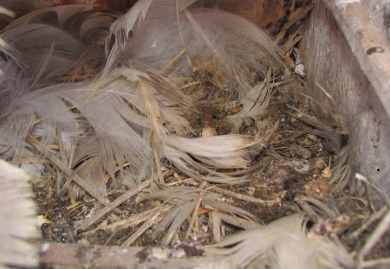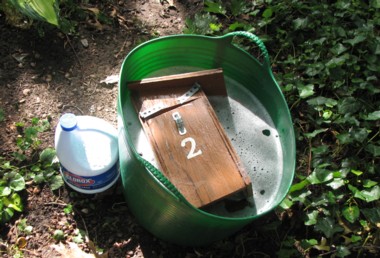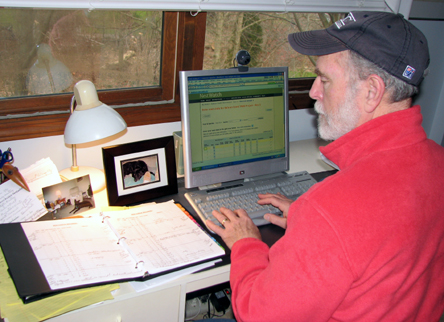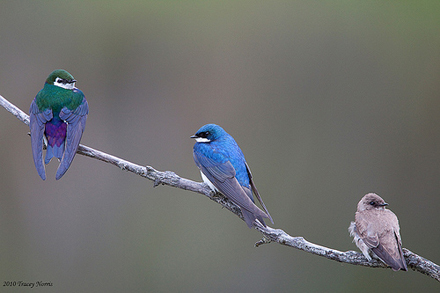At Your Boxes:
Even though nesting is over and all your Tree Swallows have left there are still things that need doing. Each nest box needs care and cleaning, and you should make a season assessment. There are records to summarize and nesting results to submit to national databases. It’s wrap-up time.

Concepts:
What should you do with the old nests?
- Old nests should be removed from the boxes. Doing this helps rid the boxes of ectoparasites of Tree Swallows that might otherwise overwinter in the nest material.
- Wear disposable gloves if you can because used nests can be messy and germy.
- When you remove nests from boxes stand so debris doesn’t blow in your face.
- Seal old nest materials in a trash bag and dispose properly.
- Exception: if there has been a major blowfly infestation, take the bag of nests elsewhere, empty them on the ground and leave them. This allows tiny wasps that parasitize blowflies to mature inside blowfly pupae that remain in the nest. Big parasites often have little parasites of their own!

Nest Box Care:
- If vandalism is a concern you may want to take your boxes and poles down.
- Also remove boxes and poles if land owners need to mow the field.
- Once removed, boxes can be hosed and scrubbed. Wear gloves and eye protection.
- Rinse boxes with a dilute bleach solution, then rinse again thoroughly with water.
- This treatment kills most ectoparasites and disease organisms that could otherwise live through winter in box cracks and surfaces.

- Let disinfected boxes dry well, then:
- Make repairs, seal cracks or perform other maintenance.
- Store boxes and poles out of the elements; they’ll last much longer.
- If you leave your emptied boxes up outside, wipe them inside and out with a rag soaked with rubbing alcohol or a bleach solution, especially if you suspect they harbor mites.
In addition to nest box care, making a season assessment will help prepare for the next year’s nesting.
- One valuable post-nesting exercise is a careful assessment of the just-completed season. Ask yourself these questions:
- Were there any fixable problems that couldn’t be dealt with while the swallows were present? How can we prevent recurrences?
- Do any boxes need to be relocated due to predation? See Protecting Boxes from Predators for more information.
- Was there excessive competition among the Tree Swallows? If so, see Nest Site Competition and Box Claiming.
- Do you need to reduce competition between Tree Swallows and other species? Check these pages for techniques:
- Reducing Competition between Bluebirds and Tree Swallows.
- Reducing Competition between Purple Martins and Tree Swallows.
- Reducing House Wren Damage to Tree Swallow Nestings.
- House Sparrow Damage to Tree Swallow Nestings.

Also ask:
- What improvements could we make?
- What experiments could we try?
- Are there issues to discuss with property owners or managers?
Share your experiences:
- If you’ve enjoyed your Tree Swallow experiences consider sharing what you’ve learned with others.
- You may find sharing directly with family, friends or community groups rewarding.
- And if you want to connect with a wider audience social media offers endless possibilities.
- Consider inviting other people to help or observe next year.
- Encourage others to create their own Tree Swallow nest box projects.
- Summarize your nest records and report them to NestWatch for the US, or Project NestWatch for Canada, so your findings will contribute to the growing scientific database of information on the breeding performance of North American cavity-nesting birds.
Use your Tree Swallow experience as a step in your quest to learn more about birds:
- We hope creating and managing your Tree Swallow boxes has truly helped you learn more about birds, and we also hope these experiences will motivate you to expand the scope of your investigations.
- Though many of the issues in a Tree Swallow’s life, its basic biology, ecology, and behavior, are the same in principle as those faced by other birds, each species has its own attributes, its own fascinating ways of living, interacting and coping with life’s issues. So, while we hope you’ll continue to enjoy and learn from your Tree Swallows, we urge you not to stop there.
- Here’s our suggestion: Pick another bird species that interests you. Find what’s being done to conserve and manage it. See if there are ways you can assist. You might be surprised at the contributions you could make.
- As for us, we’ll continue working with Tree Swallows, trying to increase our knowledge and refine our management techniques. But we are swallow-obsessed so we also want some in-depth experiences with other members of the family.
- Some year soon we hope to volunteer at a research site out west where Violet-green Swallows are the focal species.
- And if we’re going west we wouldn’t want to miss the huge Cliff Swallow colonies in Nebraska or the Cave Swallows in south Texas or at Carlsbad Caverns, New Mexico.
- Closer to home we hope to experiment with nest tubes placed under bridges and boat docks for Northern Rough-winged Swallows. Rough-wings are our sentimental favorites. Overlooked by most people, they were the first swallows we knew back in our childhood near New York State’s Erie Canal.
- The beautiful photo below showing a Violet-green Swallow, a Tree Swallow, and a Northern Rough-winged Swallow was taken by Tracey Norris in Washington.

———————————————————————————–
Home: Tree Swallow Nest Box Projects
Creating Tree Swallow Nest Box Projects
Spring Return
Nesting Season Behavior
Song and Calls
Nest Site Claiming
Pair Formation
Nest Building
Bird Flight
Mating and Paternity
Diary of One Season at Salmon Creek
Monitoring Nest Boxes and Keeping Records
Making Box Checks Keeping Box Records Control Sheets Season Summaries Print Sheets
Banding Your Tree Swallows Banding Adults Banding Nestlings
Tree Swallows in Research Research Bibliography Glossary of Terms